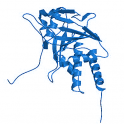
- Remove this product from my favorite's list.
- Add this product to my list of favorites.
Products
Viewed products
Newsletter
 |  |  |  |  |  |

SHP-1 consists of two SH2 (Src homology 2) domains at the N terminus, followed by a catalytic domain (PTP domain) and a short C-terminal tail. The SH2 domains of SHP-1 play an important role in the regulation of enzyme activity. In the absence of stimulus, SHP-1 is inactive through allosteric inhibition by its N-terminal SH2 (N-SH2) domain. The binding of a phosphotyrosine (pY)-containing ligand leads to a conformational shift within the N-SH2 domain, upon which the PTP domain is released and accessible for substrate molecules. SHP-1 is predominantly expressed in hematopoietic cells and at a lower level in epithelial cells. It has been recognized as a negative regulator of various immune cell functions including antigen stimulation of B- and T-cells as well as neutrophil activity. Abberant SHP1 expression is associated with various diseases including acute myeloid leukemia, lymphomas, and multiple myelomas.
Protein Informations: Catalytic subunit of SHP-1 is a single, non-glycosylated polypeptide chain (amino acids 243-541) recombinant expressed in E. coli. SHP-1 was overexpressed as insoluble protein aggregates (inclusion bodies). The protein was purified by FPLC gel-filtration chromatography, after refolding of the isolated inclusion bodies in a redox buffer. Additional amino acid (Met) is attached at N-terminus. Protein concentration: 1.0 mg/ml, Purity: > 95%, Specific activity: 5.000 U*/mg
Ordering information: shipped on dry ice
Chong ZZ, Maiese K.(2007) "The Src homology 2 domain tyrosine phosphatases SHP-1 and SHP-2:diversified control of cell growth, inflammation, and injury." Histol Histopathol. 22(11):1251-67.
Zhang, J.; Somani, A. K.; Siminovitch, K. A.(2000) "Roles of the SHP-1 Tyrosine Phosphatase in the Negative Regulation of Cell Signaling". Semin. Immunol. 12, 361−378.
Yang J, Liu L, He D, Song X, Liang X, Zhao ZJ, Zhou GW.(2003) "Crystal structure of human protein-tyrosine phosphatase SHP-1." J Biol Chem. 2003 278(8):6516-20.
Imhof D, Wieligmann K, Hampel K, Nothmann D, Zoda MS, Schmidt-Arras D, Zacharias M, Boehmer FD, Reissmann S. "Design and biological evaluation of linear and cyclic phosphopeptide ligands of the N-terminal SH2 domain of protein tyrosine phosphatase SHP-1." J Med Chem. 2005 Mar 10;48(5):1528-39.
PPM1G, 50 µg - 195,00 €
PSPH, 20 µg - 195,00 €
Follow us